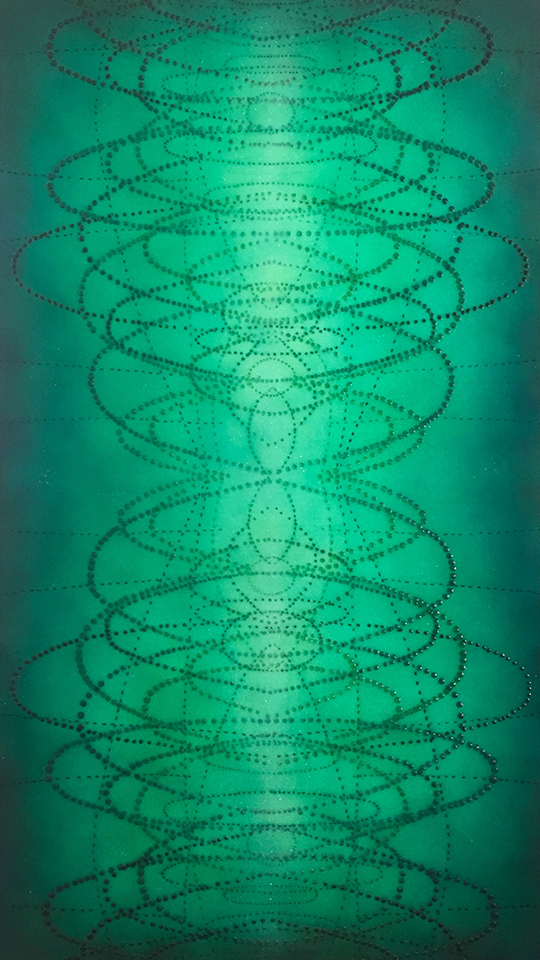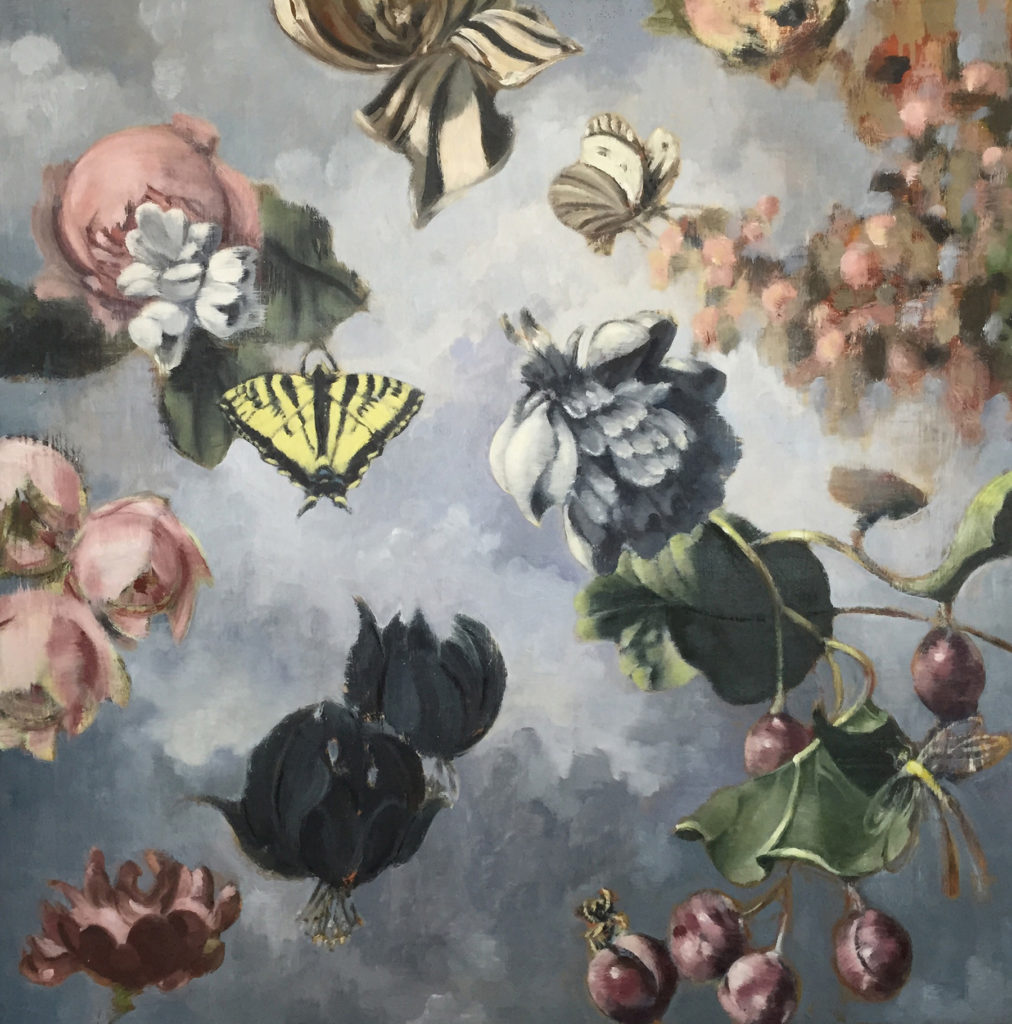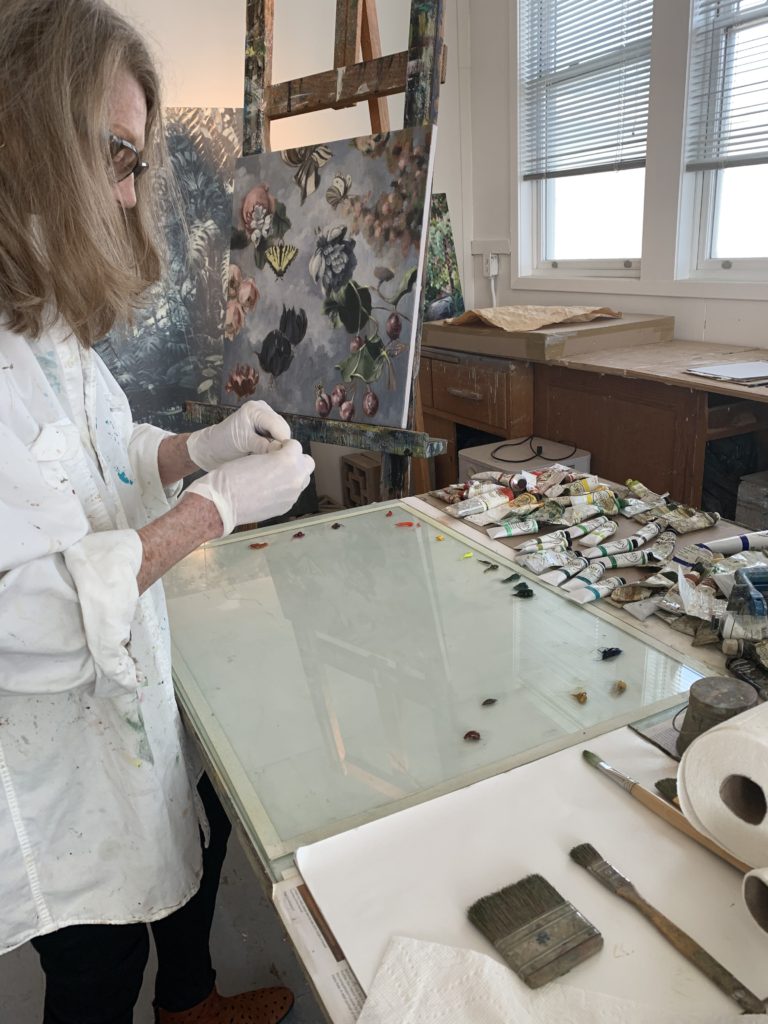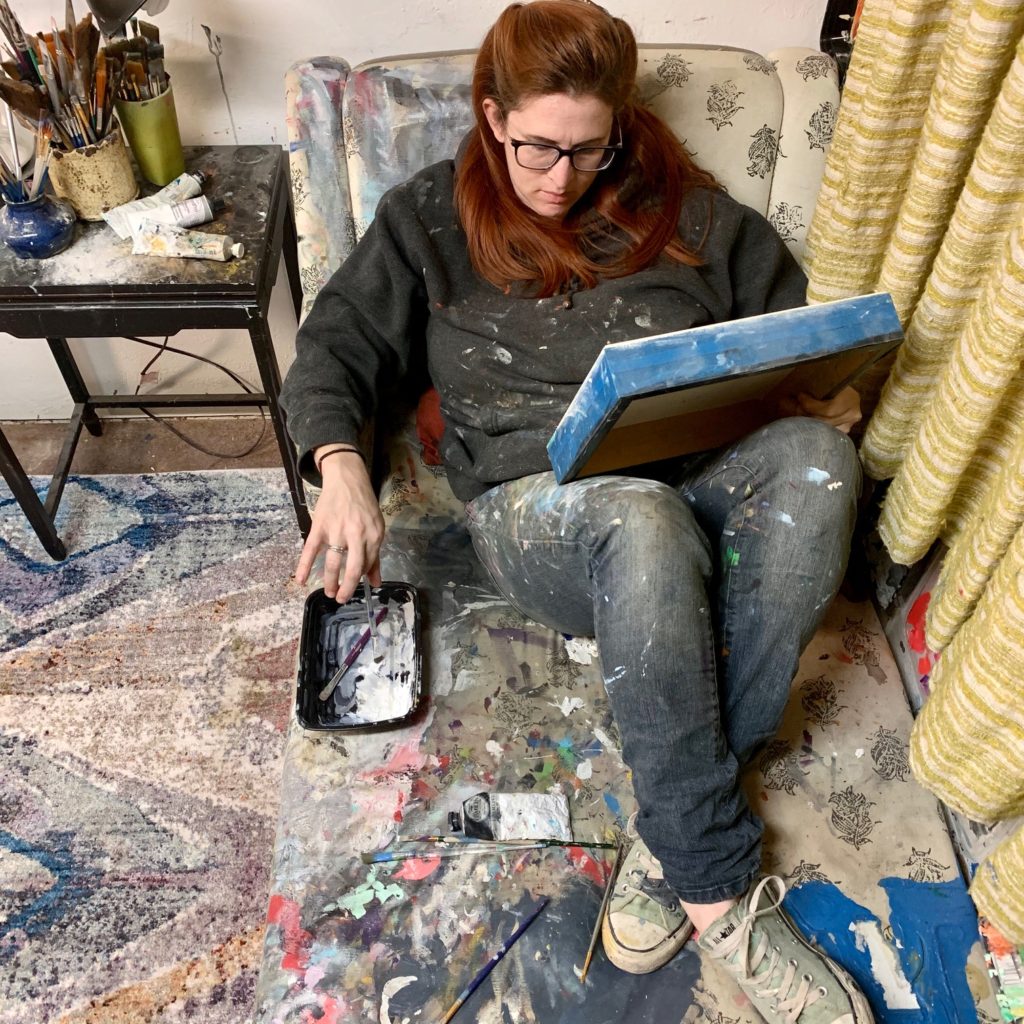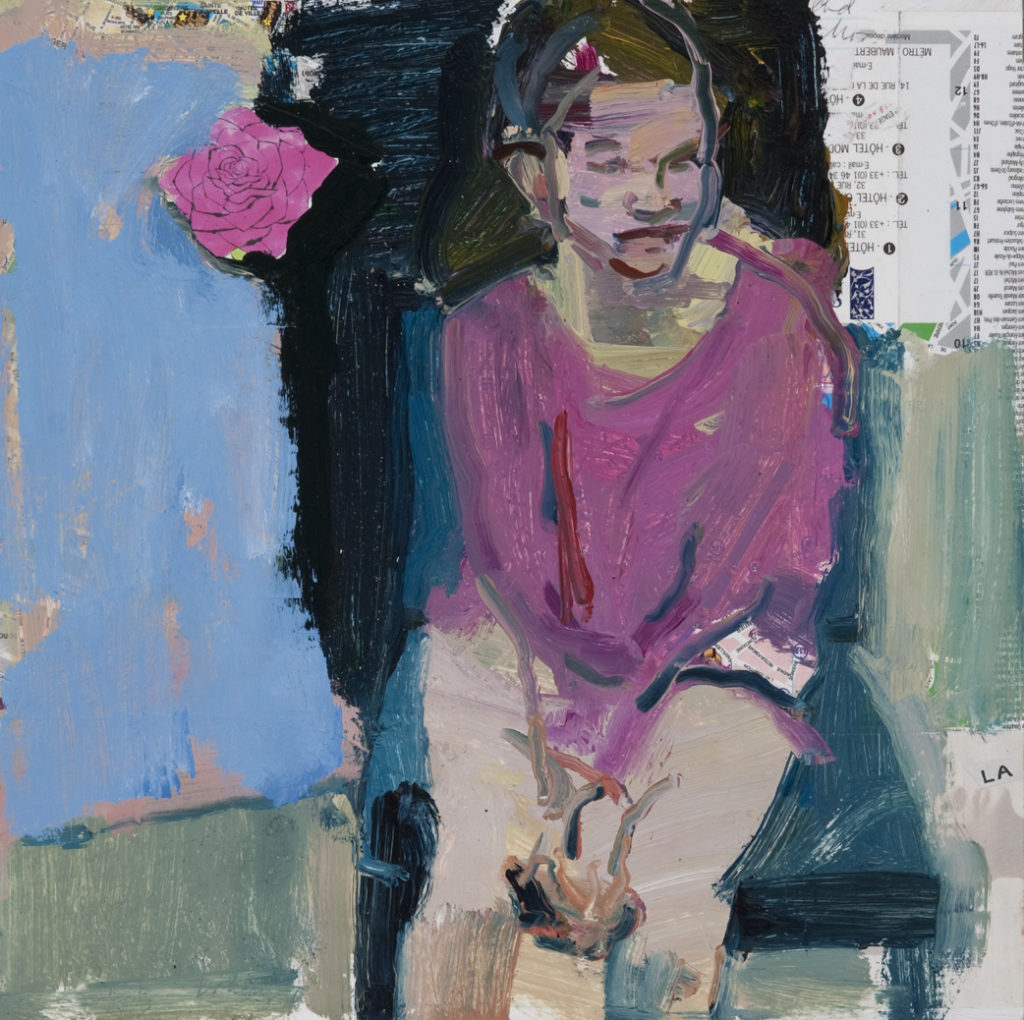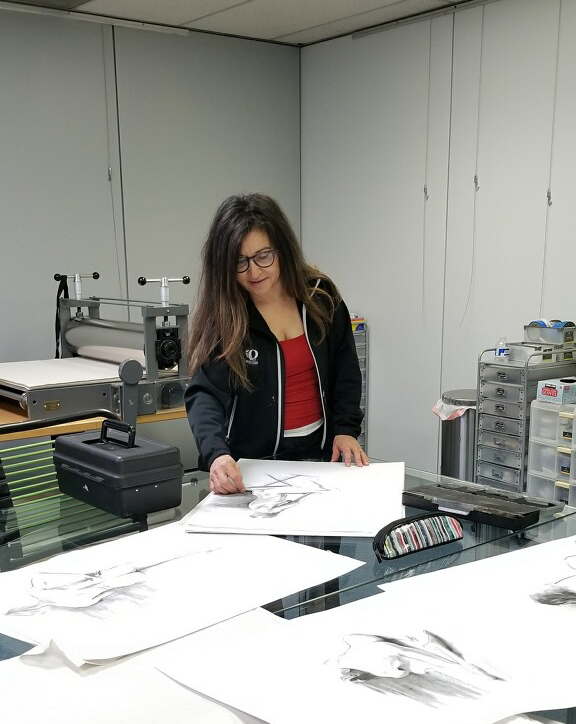31 Women – March 9th: Sherry Karver

“At the Edge of Perception”, 2018
Photo images, oil, narrative text, and resin surface
An Interview with Sherry Karver
MKM: Tell me about your childhood, where did you grow up? Were you always creative?
SK: I was born and raised in Chicago, and as an only child I found ways to be creative at a very early age. I collected rocks and shells and built little sculptures with them on the kitchen table. My father was a tailor, so often there were scraps of fabric and large shears at home that I wanted to use even when I was just three or four years old – round kid’s scissors were not for me! My mother worked for a company that made the colored squares for paint chip samples and she brought home extra samples that I cut up to create collages. I was probably the only child who knew what color aubergine or chartreuse was.
I attended children’s painting classes on Saturdays at the Art Institute of Chicago when I was about 9 or 10. Classes started before the Art Institute was open to the public, so the kids were allowed to come in early and wander through the museum by ourselves, on our way to the classrooms which were in the basement at that time. The lights were barely turned on yet, and the semi-dark, cool hallways filled with art left a great impression on me. There was a simple obscure door between the famous paintings that opened into the school section, and when I opened the door the smell of oil paint and turpentine immediately hit my nostrils and it was delicious.
MKM: Why did you pursue art? Where did you study? Memorable teachers?
SK: Although I always loved art, I didn’t seriously pursue it in college because I didn’t think there was any way I could make a living doing it, and my parents weren’t going to pay for college unless I studied something “useful”. So, I got my undergrad degree in Sociology from Indiana University in Bloomington, IN.
I took one or two art classes each semester, and during my senior year I took a class in ceramics and the rest is history. I was hooked! Clay spoke to me like nothing else ever did, and even though I had already been accepted to a graduate program in Sociology, I decided not to go, and instead started doing ceramics full-time. The teacher who inspired me in this early stage at IU was John Goodheart.
I moved back to Chicago and had the wonderful and magical opportunity to open my own ceramic shop and studio with a business partner Barbara (Bobby) Prignano. Since we were both relative beginners to ceramics, it was quite an undertaking to open a shop. I don’t know if we were just dumb, naive, or ballsy!
During this time, I went back to the Art Institute of Chicago and to Loyola University part-time and took more ceramic classes to hone my skills. The teachers who inspired me and were most supportive at this time were Harris Deller and Bill Hoffman. Also, I met the amazing ceramic artist Ruth Duckworth, who really became my main inspiration even though I never had the opportunity to study with her. She was really the only female artist I was aware of at the time who was a ceramic professor and did large scale wall sculptures in public places. To this day I love her work.
After four successful years of having the ceramic shop/studio in Chicago, I decided I really wanted to teach ceramics on the college level, so I went back to graduate school at the Newcomb School of Art of Tulane University, in New Orleans, LA, where I received my MFA in ceramics and minored in glass. My terrific teacher Gene Koss taught me the work ethic I have today, and how to compete in a man’s world. I went on to teach ceramics at San Diego State University; Chico State University; U. of Wisconsin, Milwaukee; and Laney College in Oakland, CA.

MKM: How has your practice changed over time?
SK: Although I continued to teach ceramics until just last year, and I did many large-scale 2D wall sculptures that are in numerous public corporations and private homes, my own work gradually shifted around 1996. My work evolved into photography and painting, adding narrative text around 2000. This might seem like a drastic change from ceramics, but really it was just a hop, skip, and jump away. I was already working with clay in 2D on the wall, using representational imagery, and painting on the clay. It just gradually morphed into a different medium. I still do ceramics on the side, just for enjoyment, but professionally I only exhibit my photo-based paintings, and most recently have been doing photography that is printed as dye sublimation on metal.

MKM: What themes do you pursue?
SK: I pursue a couple of different themes in my two-ongoing series. My photo-based work combines photo images that I take in public places, with oil paint, narrative text, and resin surface on wood panels. This series called “Identity and Perception”, confronts today’s individual and societal issues so rampant in our impersonal metropolitan areas: alienation, loneliness, loss of identity, time passage, and how others view us. I write fictional bios on some of the figures as a way to personalize them and make them stand out from the crowd since we each have a unique story to tell.
My photography series called “Movement Interrupted”, harnesses data corruption glitches for aesthetic purposes. I photograph my TV screen when the images pixelate due to uneven reception. It seems we are in a difficult time in history where things are disintegrating and falling apart which is what this series represents. Currently, I am focusing just on these two related mediums, but I can see pursuing more traditional oil painting in the near future. Changes in medium happen very gradually for me over time and are an outgrowth of one another.
MKM: When you’re creating what’s your daily routine? rituals, patterns?
SK: I don’t really have a daily routine or pattern. I think my routine is to not have one! The reason for this is that every day is different. I spend about equal or more time doing the business aspect of my art, so when one of my galleries asks me to send images, price list, etc. I have to do that right away. Art is a full-time business for me, and I am good at multi-tasking to make sure everything gets done, but the order of when it’s done always varies.
MKM: What is your most important tool? Is there something you can’t live without in your studio?
SK: There are many tools I can’t do without in my studio as they all work together to create my art. The computer, the printer, and my camera are essential, as are my oil paints, brushes, etc. It would be impossible to choose just one item.
MKM: Is there an artwork you are most proud of? Why?
SK: I also don’t have just one artwork that I am prouder of than another – maybe one of my large-scale ceramic wall sculptures because they were technically difficult and complex to make.
MKM: What has been a seminal experience?
SK: A seminal experience for me actually happened many years ago, which encouraged me to make the switch from ceramic wall sculpture to photo-based painting as my main focus. I had been invited to send 5 or 6 large ceramic pieces to a group show at a university in Los Angeles. The university had applied for a grant to ship all the work, but at the last moment the grant fell through and there was no money for shipping. Since my work was large and heavy, requiring separate crates for each piece, I couldn’t afford to send the work, and had to withdraw from being in the show. The university was upset about this, as was I.
Then a thought hit me – I had 6 small photo-based mixed media paintings in my studio that I had just begun playing around and experimenting with and had never shown them to anyone except my husband. I asked if I could send those instead – all fit into one box, and the university was thrilled. After sending them off I began worrying that maybe they wouldn’t be good enough in comparison to the other artists in the show (one was a NY painter), since this series was very new for me and quite ‘beginnerish’. Long story short, they were a big hit, hung in the window of the university gallery, one sold, and the NY artist and I became great friends. At that seminal moment I knew I could go full force professionally with my new series, compete on a national level, and I never looked back.
MKM: What art do you most identify with?
SK: I like a lot of different art, mainly contemporary, but I don’t really ‘identify’ with any one school or ‘ism’. I’ve always been on my own trajectory, and don’t get influenced by other’s work, even if I admire it. I didn’t have much influence from women artists, or women in general when I was in school or even now. It would have been nice to have a female mentor to look up to, but that never happened. Maybe that’s for the better – I always had to forge my own path.
MKM: What inspires you? Other artists, other women from history, your process, a theme?
SK: One wall sculpture I always liked at the Art Institute of Chicago was by Lee Bontecou, who I had assumed was a man, and was thrilled to find out many years later that Lee was a woman! Other than the ceramic sculptor Ruth Duckworth, there aren’t any women from art history that I relate to. Of course, I was aware of such artists as Sonia Delaunay, Louise Bourgeois, Louise Nevelson, and Eva Hesse, but their work didn’t resonate for me personally, though I admire their visions and technical skills.
MKM: What’s the best piece of advice you’ve been given?
SK: The best piece of advice was given to me by a friend who was a financial advisor. I called him after I made my first big sale of a ceramic wall sculpture back in the early ’90’s for $1,000. I asked if I should invest it in stocks, bonds, CD’s, etc. He said, “Invest it in yourself”. I followed that advice and bought a really good camera. I have followed that advice ever since.
MKM: What is your dream project? What can we expect from you in the next year?
SK: My dream project would be to have a solo exhibition in a major museum like NY MOMA, The Met, The Art Institute of Chicago, etc. or at a big New York gallery. I do have gallery representation in various cities, and in the next year I plan on continuing to create and show my art as much as possible. Since this is how I make my living, it’s important for me to sell my art too. I am working on getting representation in a New York gallery, as well as a local gallery in San Francisco. You can expect to see new art from me in the coming year!
Sherry Karver’s work is held in more than 175 public and private collections and exhibited nationally. She has is represented by Stremmel Gallery, Reno, NV; Patricia Rovzar Gallery, Seattle, WA; Shayne Gallery, Montreal, Quebec, Canada and Cumberland Gallery Advisory, Nashville, TN






